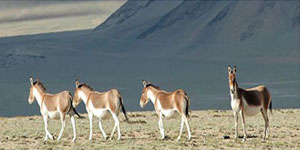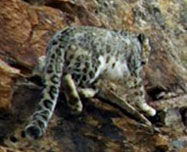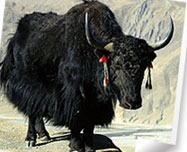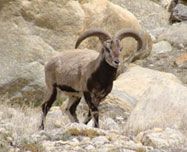WILDLIFE IN LADAKH
The animal species of Ladakh have shown an excellent ecological adaptation and flourished at an altitude where men can hardly breathe. Travellers find the wildlife of Ladakh interesting both in terms of ecological specialisation and their occurrence in the remote regions of rugged Ladakh. Ladakh possesses virtually no natural forests, though along riverbanks and valleys some greenery does exist. The lower mountain slopes are sparse but higher up, near the snow line, wild rose, willow and herbaceous plants have successfully colonized the slopes. This is the alpine zone. While soil, wind, precipitation and exposure are important determinants in the arrangement of specific life, the temperature differential due to altitude is by far the most important factor. Because of the decrease in the temperature, vegetation becomes more sparse and stunted as one ascends the slopes.
In this extremely harsh environment the untrained eye would hardly see any evidence of wildlife at all. Animals, which have adapted to the rigorous conditions however, thrive on the minimal vegetation, poor shelter, rocky terrain and bitter cold. Nevertheless, most creatures, notably the ungulates, do migrate to lower regions in winter while others, like the brown bear and marmots, choose to hibernate. Ironically, at this altitude many animals suffer from "mountain sickness" because of the lack of oxygen! Their bodies however, seem to adopt to this condition, as the number of red blood corpuscles increases along with blood acidity. Most large mammals have a unique devise for protection against the cold a highly insulated shaggy coat.



 Birds
BirdsThe Bactrian magpies, Turkoman rock pigeon, desert wheaters, buntings, larks, kite, kestrel and many kinds of finches, ducks, geese and hundreds of species of rare Himalayan birds inhabits the region of Ladakh. Many migratory birds can be seen in Ladakh during the summer month. The most famous of them is the Black-necked Crane, which can be seen in V-shaped formation across the clear Himalayan sky.
Ask for details ITINERARY
 Snow Leopard
Snow LeopardThe greatest attraction of Ladakh is the Snow Leopard. The Snow leopard is one of the rarest wild animal. The Snow Leopard faces extreme threat from the poachers as their skin being popular in Tibet is smuggled and sold in the local market. The Snow Leopard is one of the endangered species and is officially a protected animal.
Ask for details ITINERARY
 Yaks
YaksYak (dong), a wild ox is the largest animal of the cold desert. Yak was first described only a century ago by the famous Russian naturalist and explorer, N. M. Przewalski as most imposing than its placid domestic counterpart. Yak is immensely shaggy and weighs about a ton. It has curved horns whose tips can be as wide apart as 90 cm. and measure 76 cm. over the curves. It can easily be distinguished by its long black hair, which is tinged with gray at the muzzle. The yaks graze on the Himalayan valley at the height of over 6,000 meters in summer. In the winters, yaks migrate to lakes, marshes and lower valleys.
Ask for details ITINERARY
 Bharal
BharalBharal, a blue sheep can be seen at the height of 6000 feet. In summers they graze on the rich and abundant grasses of the alpine meadows. Their brownish-gray color provides them with protective camouflage and as they often stand motionless they can be extremely difficult to spot but, when alarmed, Bharal will bolt swiftly to safety. As this species of sheep posses the appearance of both sheep and goat, so they play a vital role in the mythological stories related to Buddhism.
Ask for details ITINERARY






